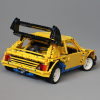Search the Community
Showing results for tags 'L-motor'.
Found 6 results
-

[MOC] Sporty snow tracker
zux posted a topic in LEGO Technic, Mindstorms, Model Team and Scale Modeling
Hi everyone. This is probably my first successful MOC created after dark ages (couple of others are unsuccessful in progress). We had a small contest for members of our BalticLUG living its early days, the main idea was to create a MOC related to winter, snow and ice. No strict rules, except splitting for active and static MOCs. Since joining EB and looking all those awesome crawlers and TT I wanted to create something you can drive outside. So winter is a perfect time for this as there are no mud or sand, just frozen water. I have created a sporty looking tracker. It is almost a C-model of 42006 set, with just like 4 extra parts and PF stuff. C-model idea comes quickly, once you disassemlbe 42006 set and observe the variety of parts it offers, however it limits the number of functions. Build process was fun and a bit challenging, as a space is a bit of an issue. The final result isn't as much as I expected. While model drives quickly on a carpet and flat surface it didn't perform as good on hard snow (slipping) or a softer one (not much of a torque). Anyway it was fun and no damage has been made, even the baterry box on the bottom didn't have a scratch. Specs: 30 studs in length (including spoiler ) and 20 studs in width 2 PF L-motors, one motor per tracks side PF IR-receiver V2 Standart BB Some more photos Instructions (photo sequence) available for download -

Two L-motors plus crowdsourcing equals....?
Commander Smith posted a topic in LEGO Technic, Mindstorms, Model Team and Scale Modeling
Hi everybody! What could I make with two rc-controlled l-motors? Thanks! P.S. Why do I have to press keyboard buttons more than once for eurobricks to recognize it? (Otherwise I get this: hi everybody!whatcouldi ak with worctrlldl-mor?) -

[HELP] RC Car with Two Motors
Commander Smith posted a topic in LEGO Technic, Mindstorms, Model Team and Scale Modeling
Hi! I know that these "I don't know what to build" topics are kind of annoying, but I have no idea how to build an r/c car with functional steering. I want to have it be 2wd. Thanks!- 5 replies
-
- L-motor
- power functions
-
(and 1 more)
Tagged with:
-

88003 PF L and 88004 Servo finally sold at LEGO.com!
le60head posted a topic in LEGO Technic, Mindstorms, Model Team and Scale Modeling
Great news! The 88003 PF L-motor and the 88004 PF Servo motor are finally being sold separately at shop.lego.com! Thank you TLG!- 36 replies
-
I recently purchased 2 XL motors from Lego direct. I noticed one of the motors has a higher pitched sound, almost a slight grind. It spins up faster and slows down slower than the other XL motor which sounds smooth and stops quicker. Has anyone noticed differences between one motor to the next? When direct coupling motors without a differential one motor will be straining more than the other which can't be good. I am curious if I should contact Lego about this noise and speed variance between the two.
-
Contents of this re-post were kindly resurrected from the 5 days of lost topics by Boneparte. ----------------------------------------------------------------------------------------------------------------------------------------------------------------------------------- This is my MOC of the ubiquitous British Class 08 diesel shunter in 8mm:1ft scale. It has been eagerly awaited by those involved in the PF L-Motor discussion. I'm now at the stage where the functionality and basic body are there but I still have the trimmings to do - railings, ladders, fuel gauge, buffer beam and grille improvements, as well as cutting down the rods and their pins. On a Hornby layout these engines melt into the background so I wanted to make this a bit special. My plan was to create the model with 3 essential functions: - Maximum speed around the design speed of 20mph. - Minimum steady speed of 0.5mph for shunting at prototypical speeds. - Decoupling to remove "Hand of God" operation. The model contains a gearbox, actuated by a PF M-motor, which selects between high ratio, low ratio and decoupling. The drive motor is a PF L-motor and the wheels are from an Emerald Night set. Lots of traction with the red belts! I have put functionality before aesthetics as usual. The loco is in Cotswold Rail livery, of which no. 08871 is an example. i understand the company owns 6 of this class of loco. I took the easy route so far, just quantising the livery into brick widths and plate heights. As long as it's recognisable it'll do because I'm not trying to represent them. The grey with bright lettering will make a change from the green or blue of many other British locos. In order to create the functions, the two motors, gearbox and IR receiver have to fit inside. This means the model is slightly long for the scale but at least it fits into the required height and width. The length is grille + 2M of IR receiver + 8M of battery box + 7M of motors + gearbox + cab end. The coupling system can cope with the extra length so there is no compromise on shunting ability. The wheels are a bit small for the scale but this is common to other vehicles at this scale using standard LEGO train wheels. The Emerald Night wheels were selected for red-belt traction in preference to the larger BBB wheels that do not have a belt groove. The loco has two of the distinguishing features, the first is the yellow radiator grilles on the front. I could add more striped tiles to the side battery boxes later: The second is the yellow striped cab end, for which I cut up a few 1x4 tiles, ensuring that I could use both halves of every one I cut: The cab end windows would be nearer the sides on the real loco. This would be difficult to make, requiring a lengthways cut of 1x4 tiles and then a few 0.5x1 parts for the other side. This was a cut too far, but might be a sticker job for someone else. The IR receiver is nicely hidden at the front, behind the radiator grilles that open just like those of the real loco. This allows for changing channel. The grilles will pass IR light easily enough and I used clear plates behind them to also pass the light through to the receiver. It still needs care because the controller has to be able to see the front to operate it! I tested the loco through the fiddle yard of my large looped-eight layout. I think insufficient speed is a greater challenge than lack of IR controllability. I made an IR repeater circuit for use in tunnels. One criterion for exhibition is that the public should always be able to see a train moving at a show. Spending too long hidden in a fiddle yard will not do! Therefore I'm happy with this loco stayng on top in the yard, leaving other locos to do trip workings. I will take and post more internal pics in due course because I'm sure you'd like to see the gearbox! For now here's an underneath pic: You can see the coupling mechanisms using 2x8 plates with holes. These connect to the 9M racks that are supported by 5M black studless beams. From each rack there is an axle with a z16 cog on the rack and a z8 cog driven by a worm. The 2 worms are on an extended shaft driven by the gearbox and each has the same amount of play in its axial location. This allows lateral movement of the coupling over a limited range to cope with changes in the track curvature. The range is moved by the decoupling mechanism. In the picture the decoupling drive would send one coupling up and the other down or vice versa. The direction may be selected because the decoupling operation might take place on a curve in either direction. The z24 cogs keep the wheels in sync and the rods are more for show. I have a prototype where the rods did the work successfully. The drive omes from the gearbox onto the middle cog. This is in preparation for a test to see whether another chassis could be articulated whilst keeping the wheels in synce with the chain of cogs. This would have variable legth rods, a technique I used on by Class 14 loco. The idea of the articulation is that the chassis at the moment is the longest that can get round standard curves. It is also OK on flexitrack but needs to take care on points, especially with the moveable blade and the check rails. It would be nice to improve reliability of operation over points, especially for a shunting loco! The light bley parts with 2 pins each are the main Technic to stud connectors. Studded beams with holes are used in the cab and these hold the cab end body to the Technic parts of the gearbox. At the left hand end you can see some of the cogs in the cab, either side of the coupling 2x8 plate. I used 2x4 tiles and some hinge bases to hide varous cogs because they extend to more than 6-wide inside. One window is a composite for the same reason. The gearbox width is the reason the bodyside grilles by the cab windows currently stick out too far. I plan to revise that bit. On the roof the IR receiver plug is clearly visible on top of the PF LiPo battery box. I was pleased to be able to minimise studs on the roof on this occasion - a number of my trains might benefit from a refresh in this aspect, now that we have a good range of cheeses and curved parts. There is a 2x2 tile that sits proud, covering the on/off switch. Originally it was just the tile and a 1x1 round plate underneath but I added a minifig flipper to help the tile to stay in its slot. I might change this if another part is more suitable but it needs to have a small bit to actuate the button and a stud on top to attach the tile. I am particularly pleased with the crawling ability of this loco. It has been able to push a heavy loco with two depowered 9V train motors, enabling it to shunt locos as well as rolling stock. LEGO trains have had issues with crawling ability, either being unable to get enough torque at low speed or overheating 9V train motors in the process. Therefore this gearbox technique applies particularly to fans across the pond where trains go so slowly! I would put a gearbox in a larger loco so as to have a crawler gear and a high-speed gear. The gear ratio between low and high speed is currently 9:1 for 0.5mph minimum and 20mph maximum and is a squeeze in this loco, not so bad for a large loco. However, some motor torque is robbed by having the geartrain connected because in high ratio the motor has to turn the low ratio shaft 9x as fast! A higher ratio would suffer more in this respect, whatever the loco size, so a high speed of 60-70mph for a large loco (3x as high) would be a challenge. I have some ideas about this though. This is a true Power Functions loco - crammed in with a skin of bricks! I am considering whether adding lights is possible - there is a small space in the cab that might fit their 2x2 bricks! This folder has more whole-model pics and I will post some internal photos soon, but please let me know what you think so far. ------------------------------------------------------------------------------------------------------------------------------------------------------- Since the original post I am investigating whether it is possible to make the lower chassis flexible, allowing the front and rear wheels to steer. This will improve performance on curves and especially points. If it works I'll use flanged centre wheels and replace the rods with flexible ones more like those on my Class 14 loco (colour TBD). I deliberately made the drive from the gearbox go to the centre axle with this in mind so I hope the upper body doesn't have to change too much. The key at the moment is making the chassis pivot points rigid so that there is negligible vertical movement - just enough to work with a change of track slope. Mark


